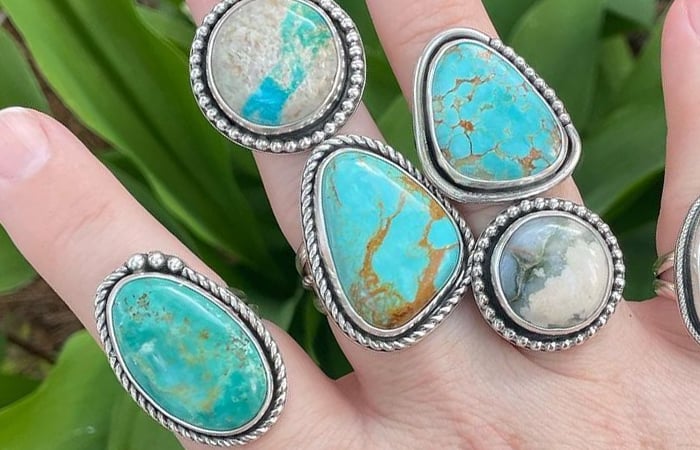Turquoise is one of the first stones that were ever mined in the world and is valued for its intense color. The birthstone of December, the classical era’s stunning sea-green stone is a symbol of protection, wisdom, hope, tranquility, and good fortune.

If you want to retain the beauty of turquoise that is reminiscent of the sky and the ocean, learning how to care for this stone should be one of your top priorities.
How to Clean Turquoise
Almost all types of crystals share the same characteristics once exposed to chemicals or water. The best way of cleaning your turquoise is to use soapy water or warm water.
You can also use wet soft cotton. You can also put some soap on a piece of fabric and dab it on the stone. Avoid pouring soap directly on the stone as this will only cause some harmful effects. Use gentle motions when wiping the stone with a soft and clean fabric. Dry the stone using soft and dry cotton. Again, be sure to wipe it gently and slowly.
If you have very old vintage pieces that feature untreated stones, carefully remove any thick dirt and debris from the metal setting using a toothpick. Just make sure that you don’t touch the stone to avoid scratching it.
Most collectors also prefer keeping the natural patina since polishing may end up devaluing the piece. For more valuable pieces, it is recommended to take your turquoise to a professional jeweler who can repair or clean it for you.

Avoid using steam, chemicals, soaps, and ultrasonic cleaners for cleaning turquoise that is set in jewelry. Don’t forget that most turquoise gemstones undergo treatment to boost their appearance, which means that solvents and heat may end up damaging the treated surfaces.
Finally, never use abrasive cleaning products. Cleaners with ammonia and baking soda, for instance, can ruin the finish of turquoise whether it is stabilized or not.
How to Store Turquoise
When storing your turquoise, you should place every piece in a pouch, and wrap it in a cotton cloth, or the original box that it came in to protect the stone from scratches. It will also help protect the precious metals and softer stones from being scratched by turquoise. It is also a good option to invest in jewelry boxes with individually padded spaces to prevent scratches and damage.
How to Charge Turquoise
When it comes to charging turquoise, the method it loves the most is to smudge it with sage or other herbs of your preference. Turquoise also loves sitting under the moon through the night when it can bask in the luminous lunar vibes. To preserve the shimmering high shades of your blue and green turquoise, never leave it in direct sunlight because this can make the coloring fade away.
How to Cleanse Turquoise
Turquoise can experience discoloration because of the natural oils of the skin, which necessitates regular cleansing in running clear water.
You can also occasionally cleanse and clean your turquoise in saltwater. Although the stone is porous, you need to be extra careful, so you don’t end up overexposing it in saltwater for a long time.
For your turquoise to work at its best and clear it of the negative vibrations that the stone might have absorbed, you can smudge it with white sage smoke or cover it overnight in brown rice.
How to Display Turquoise
The turquoise gemstone is highly aesthetic, lending itself to various applications. If you like to keep it near you to serve as a gentle guiding light that will inspire self-confidence and self-care, it is recommended to wear it as a form of necklace or pendant. This will let the gemstone stay close to your throat chakra which can maximize the energy exchange that takes place between yourself and the turquoise gemstone.

It is also highly recommended to keep some turquoise stones around the house to allow its lullaby-like energy to flow into all corners of your home.
You can also display it in the office to attract wealth and prosperity. If you need help addressing chronic insomnia, you can put a turquoise gem under your pillow at night.
If there is some recent tension or conflict in your home, you can also try keeping some turquoise in the communal spaces. This will help encourage calm and constructive communication.
Precautions
Natural turquoise is porous, except for some Southwestern and the very finest Persian specimens. The stone turns greenish when it ages because of its interaction with the skin oils of the human body. This is why older Native American pieces feature a greenish tint because of the oils from the skin and elsewhere that accumulated through the years.
While this is natural, you should still avoid dish wash water, dish soap, soap, hot water, coffee, tea, sunscreen, lotion, oil-based substances, or soaking in water. These will alter the color of a natural turquoise stone.
Despite being relatively light-stable, turquoise can become discolored or even suffer from surface damage when exposed to high heat. It will also dissolve little by little in hydrochloric acid and can get discolored by perspiration or skin oils, cosmetics, or other chemicals. You should also avoid exposing your turquoise to sulphuric acid or bleach.
Tips When Wearing Turquoise
Just like other crystals, it is always good practice to remove your turquoise jewelry after every use to keep the stone protected. Never carry other hard surfaces or metals while wearing your turquoise pieces. These will not only scratch the stone but may even become discolored once exposed to the different chemicals.
Turquoise is also a porous material with a great affinity for grease or oils, absorbing them like a sponge. This is why it is never recommended to wear your turquoise jewelry while wearing lotion. This will only affect the texture and color of the stone.
It is also not advised to wear your turquoise jewelry when in a swimming pool or taking baths because the chlorine may compromise the stone.



